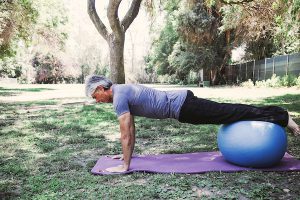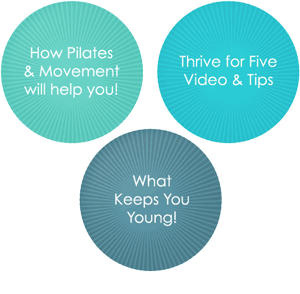The plank has been heralded by many as the key to a great set of abs. The plank is a favorite among Pilates instructors because it challenges the entire body, requiring the whole body to work together from head to toe. Requiring no equipment and little space, the plank is a convenient exercise to have in your repertoire.

To perform a plank, begin on your hands and knees. You may also perform a plank on your forearms. Be sure that your hands (or elbows if you are on your forearms) are directly beneath your shoulders. Actively push the floor away while you draw your shoulders broad and down your back, away from your ears. Pull the belly button toward your spine by cinching your waistline while you slightly round your low back with a small clench of the glutes. Now step back one foot at a time into a plank position, forming a small round arch from your heels to head. Now that you are in position, let’s take a quick survey of your body from head to toe to ensure a safe and healthy engagement.
As the very top of the spine, your head should be aligned with the rest of your spine. Don’t let it drop to the floor or lift too high by wrinkling the back of your neck. While planking, it is easy to sink into the shoulders and wing the shoulder blades as well as to round the shoulders forward and into the ears. Avoid both pitfalls by pushing the floor away, pulling your shoulder blades toward your bum, engaging the armpit muscles like you are trying to hold something there, and drawing your heart forward to avoid over-rounding the upper back. Avoid locking your elbows by keeping the creases of your elbows facing each other rather than facing forward.
Continuing the full-body engagement, keep your core engaged and working during the entire plank. Do not let your belly and pelvis drop beneath your shoulders. With every exhale, pull your belly button from the floor as if a sling around your waist was holding you up. Simultaneously slightly squeeze your booty muscles and round your low back. Be careful of overusing your hip flexors by sticking out your bum. Remember that you want to create a small round arch from your heels to your head. Your legs should be engaged as well to support the plank. Squeeze the inner thighs together and activate your quads to avoid locking your knees.
Perform your plank in front of a mirror to check your form, ensuring that each part of the body is properly engaged. When the entire body is working together to maintain a plank, you will gain the most benefit from this exercise while protecting yourself from strain or injury.
Happy planking!


Hey, Very useful & informative article. I love doing plank. I have back pain problem. Plank has helped me a lot in reducing my back pain.
Thanks for sharing such a nice post!!!